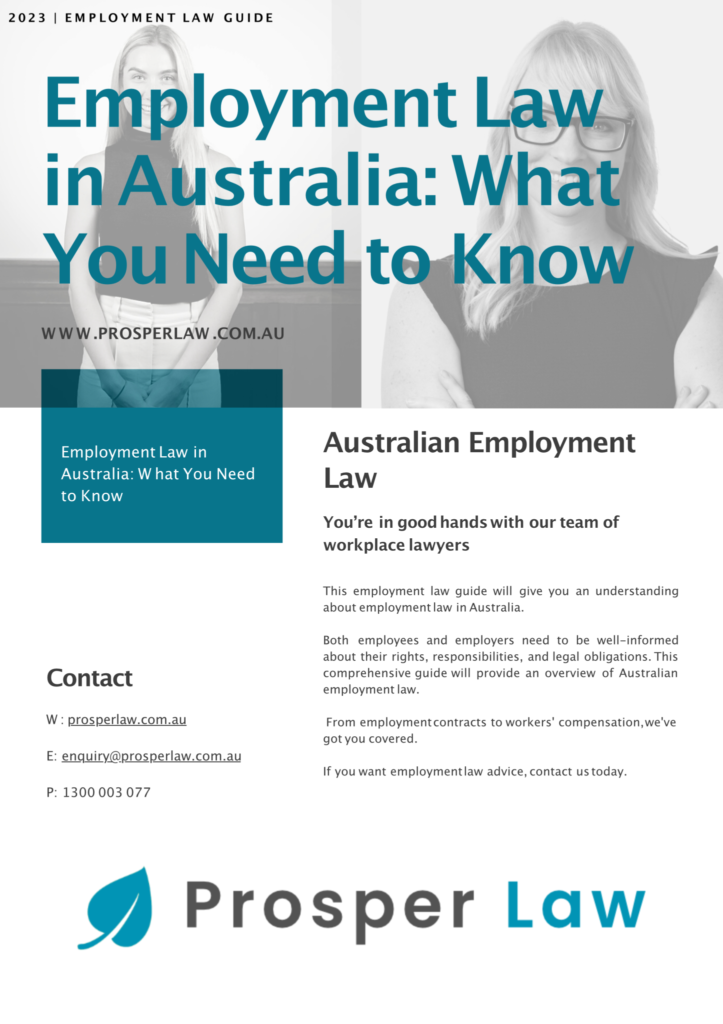Under the Fair Work Act 2009 (Cth), employees taking unpaid parental leave are entitled to return to their original position or a comparable one. But what happens when business needs change – and the role no longer exists?
In this article, our workplace rights lawyers explain how the return-to-work guarantee applies when redundancy during parental leave arises. We outline your legal obligations as an employer and how to avoid adverse action, unfair dismissal, and general protections claims.
Key Takeaways
Employees on unpaid parental leave have the legal right to return to their original role (or an equivalent position) at the end of leave.
Redundancy during parental leave must be genuine and well-documented.
Employers must consult with employees on leave and explore redeployment options.
Failing to follow Fair Work requirements can result in significant legal and financial consequences.
Legal advice before making redundancy decisions can help protect your business.

What is the Return to Work Guarantee?
The return to work guarantee under the Fair Work Act ensures that employees returning from unpaid parental leave are entitled to:
Their original position held before leave, or
A role that is comparable in pay, duties, and status if the original no longer exists.
To be eligible, an employee must:
- Have completed at least 12 months of continuous service with their employer
- Be employed by a business that is covered by the national workplace relations system (this includes most private sector employers in Australia)
- Have taken approved unpaid parental leave, including birth-related leave, adoption leave, or special maternity leave
For a step-by-step breakdown of how to manage redundancies lawfully during parental leave, read our Employer Guide to Redundancy During Parental Leave.
Understanding Redundancy During Parental Leave
A redundancy occurs when an employer no longer requires a role to be performed, often due to restructuring, downsizing, or operational change. However, making an employee on parental leave redundant is legally complex.
Employers must ensure the redundancy is genuine, follow consultation requirements, and offer any suitable alternative positions to the employee. Failing to comply with these obligations may result in general protections or unfair dismissal claims.
Remember: A redundancy based (even partly) on an employee taking parental leave may amount to adverse action or discrimination.
To better understand how parental leave ties into general protections laws, explore our article on Parental Leave and Adverse Action.

Legal Requirements for Employers
When managing redundancy during parental leave, the following steps are essential to meet Fair Work obligations and minimise legal risk:
1. Prove Genuine Redundancy
The employer must be able to show that the redundancy is legitimate, meaning the position is no longer required.
This includes:
Documenting the business reason for the restructure
Showing that the employee’s duties are no longer required
Ensuring no other employee is simply replacing them
2. Consult With the Employee
Even though the employee is on parental leave, the employer must consult them about any changes that could affect their employment, including redundancy.
Failure to consult can result in civil penalties and unfair dismissal claims.
3. Explore Redeployment Options
If the employee’s role is redundant, the employer must consider if there are any other roles in the company that the employee could fill, even if the employee is on leave.
You can read more here about suitable alternative roles and redundancies.
Want to ensure your policies align with national employment standards? See our overview: The Fair Work Act – A Guide for Employers.
Return to Work Guarantee vs. Redundancy
The return to work guarantee applies at the end of parental leave, unless a genuine redundancy has occurred.
If the employee’s original role no longer exists, you must:
Offer a comparable role (if one exists)
Communicate all available positions
Avoid selecting the employee for redundancy because they took parental leave
For employees: If the redundancy involves maternity leave specifically, our article on Redundancy During Maternity Leave: Know Your Rights offers helpful guidance for employees.
Case Law Examples: What Can Go Wrong?
Power v BOC Ltd
An employer was found to have taken unlawful adverse action against a pregnant employee. The employer brought her notice of redundancy forward to a few days before she was due to commence parental leave.
Although the employee’s termination was a genuine redundancy, the timing of her redundancy (before others in the company) was motivated by a prohibited reason. In particular, the employee’s pregnancy and entitlement to parental leave.
The Court found that because of the employer’s actions, the employee could not rely upon the protection of the “return to work guarantee” in the FW Act. The employee was also denied access to the employer’s lucrative paid parental leave policy.
Turnbull v Symantec (Australia) Pty Ltd
Turnbull brought an unfair dismissal and general protections claim arguing her termination was unjust, claiming that Symantec dismissed her in retaliation for exercising her workplace rights.
The FWC found the dismissal was based on documented performance issues, not retaliation.
Employer lesson: This case shows that while employers can dismiss staff on performance grounds, clear records are essential.
Frequently Asked Questions
Can an employer make an employee redundant while they’re on parental leave?
Yes, but only if the redundancy is genuine and not connected to the fact that the employee is on parental leave. The employer must ensure that the redundancy is due to operational needs and must follow proper procedures, including consultation and offering any suitable alternative positions.
What happens if the employee’s position no longer exists when they return from parental leave?
If the employee’s original position no longer exists, the employer must offer a comparable position. If there is no comparable position available, the redundancy may proceed, but the employer must demonstrate that they have explored all other options.
Is it unfair dismissal if an employee is made redundant while on parental leave?
It could be considered unfair dismissal if the redundancy is not genuine or if proper procedures are not followed. Employees can file a claim with the Fair Work Commission if they believe they were unfairly dismissed while on parental leave.
What should an employer do to avoid legal issues when making someone on parental leave redundant?
Employers should ensure that the redundancy is genuine, consult with the employee even though they are on leave, provide any available redeployment options, and follow the legal requirements outlined in the Fair Work Act. Documentation and transparency are key to avoiding legal disputes.
Can an employee refuse to accept redundancy while on parental leave?
Employees cannot generally refuse redundancy if it is genuine. However, they may challenge the redundancy if they believe it was not based on a genuine need or was related to their parental leave.
Employers must also consider their responsibilities beyond leave periods. Learn more in our guide to Employees with Parental Responsibilities.




